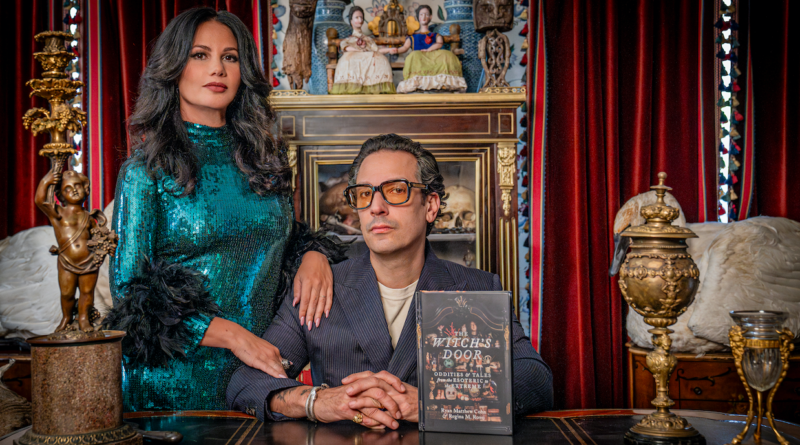INTERVIEW: New book details Regina M. Rossi and Ryan Matthew Cohn’s gloriously odd life
Photo: The Witch’s Door is the new book from Regina M. Rossi and Ryan Matthew Cohn. Photo courtesy of David Zeck / Provided by Mouth Digital PR with permission.
Ryan Matthew Cohn and Regina M. Rossi’s new book, The Witch’s Door: Oddities and Tales From the Esoteric to the Extreme, is a gateway into the collecting lives of this married couple and how they have traveled the world for hidden treasures and macabre memento mori. They share stories of how they first met, how the television cameras turned up for their wedding and their general philosophy when it comes to trading in rare objects. Along the way, readers have a chance to learn more about their exquisite collection, which includes everything from a wooden door believed to be from the time period of the Salem witch trials to wax figures, a Tibetan Kapala skull and taxidermied animals.
Cohn and Rossi stay busy year-round with their collecting business. In fact, today, Dec. 7, they are bringing their successful Oddities Flea Market to Manhattan’s Metropolitan Pavilion. Visitors will have the chance to get the new book signed, but also purchase a trove of odd objects from a variety of vendors.
“It’s an easy book to read,” Cohn said in a recent phone interview. “I feel like I have a lot of friends that read it in two days. That’s good, I think.”
When Cohn and Rossi were thinking of creating this book, they were at a crossroads almost immediately. Because their collection is visual, a coffee-table book first came to mind, but they were convinced that the stories behind the objects were as interesting as the objects themselves. They then recalibrated to a more traditional tome, one that offers narrative viewpoints from both authors.
“I think my first intention has always been a very visual one,” Cohn said. “Everything that we do is very visual; however, we tell our stories pretty frequently, maybe at a dinner party or just explaining what we do to somebody. And people are always very intrigued about the stories, sometimes even more than the actual objects themselves. So, when we were toying with the idea of writing a book, [the publisher] Chronicle said, ‘Hey, we can do a coffee-table book anytime. I think that a story or a compilation of your stories and how you fell into this stuff or how you became so interested in this stuff over the years would be far more interesting and have a bit more longevity.’ And so we decided to do more of a book of our tales, our adventures, if you will.”
The book also serves as an autobiography for the married couple. Rossi opens up about her start in the fashion industry, while Cohn’s section discusses his rise through the flea markets of New York City. Eventually their relationship culminates in the reality show Oddities, their televised wedding and their launching of the Oddities Flea Market.
“We’ve always been very quiet about that stuff, to a certain degree,” Cohn said. “It was kind of nice to talk about how Regina and I met because the whole book is really about that, in a way. We wanted to be sure to tell it from both of our points of view, which I think is an interesting way, especially if you’re writing a book with someone. I didn’t see too many like that, but I have a very different mind than Regina does. I come from a much different place when it comes to, for instance, buying an entire museum’s worth of things. I visualize what I’m going to do with it. I can think about the first, middle and next and last steps when I’m dealing with a large collection. She has a totally different point of view, and I thought it was really fun to show both of them because many times they’re very much opposing opinions and views on what we’re doing. I come from a place of passion. She almost comes from a place of business.”
The Witch’s Door also serves as a cautionary tale for those looking to break into the collecting business. Many of the objects command steep prices, which can prove prohibitive to many people, but once overcoming that hurdle, there’s also the issue of addiction and hoarding. Collectors need room to store their collection, and sometimes the objects take over their lives. Cohn and Rossi write about various collectors they’ve encountered who didn’t know how to say no.
“It’s a cautionary tale,” he said. “I would say that 50 percent of what I end up procuring is someone reaching out to me saying, ‘Hey, my husband passed away or a colleague has suddenly passed away, and I’m just getting my foot in the door.’ And then [we see] what’s there, and you never really know what’s going to be behind someone’s closed doors. They could have a persona online where they have this museum-like collection, and then you get to their house. “
For example, one chapter of the book surrounds a somewhat mysterious figure given the name Nick Parmesan, who lived in Brooklyn along with Rossi and Cohn. After he died, the couple helped the family with the collection, which had turned Parmesan’s brownstone apartment into a maze of objects with hardly any room to live.
“That guy had probably about 3,000-4,000 objects in the house,” Cohn said. “Piles of one type of T-shirt with the tag still on, he had a hundred of them, mixed with all kinds of gross other things because he was getting sick, so I think he just stopped caring about his day-to-day life. I deal with that on a regular basis, but I also made sure that I’m not becoming a hoarder because I do have a tendency to say yes. I think the only difference between Nick and myself is if I can’t display it, and I can’t do something with it, I don’t have any problem with parting with something, selling something and/or occasionally saying, ‘No, I can’t facilitate a deal right now.’ But if there’s something very rare or a collection that’s very rare that I think we can utilize in the future, I’ll typically purchase it. Sometimes things do accumulate down in the basement. That’s the place where I check in to make sure that I’m not sick in the head. All right, I can still easily move through this aisle of things. If it gets too much, we’ll do an antique show, and we’ll sell some things. Or things will go up for auction.”
Cohn added: “Everything at the end of the day is disposable. I’m not going to get buried with thousands of pieces. I was looking at a table today that I have on the second floor, and I don’t know, I’ll do this sometimes where I’ll just, for the fun of it, just count how many objects are on a table. It doesn’t look like much because I pass by it all the time and am almost desensitized to the fact that all these objects are just laid out on this table. There were 60 objects on the table. That’s just one table. We have a lot of square footage in this house that we moved to in Connecticut.”
One motivating factor for Cohn and Rossi to collect, but not collect too much, is that they have a game plan for where their lives — both personally and professionally — are headed.
“There is an end plan,” Cohn admitted. “Most collectors want their collection to go to a museum or something, but 99.99 percent that doesn’t happen unless it’s incredibly important. I think at some point we will sell the collection and just move on with our lives and do something else, but I’ll always have it in my blood. I don’t think I could ever just stop. I can scale down.”
By John Soltes / Publisher / John@HollywoodSoapbox.com
The Witch’s Door: Oddities and Tales From the Esoteric to the Extreme by Ryan Matthew Cohn and Regina M. Rossi is now available from Chronicle. Click here for more information.

